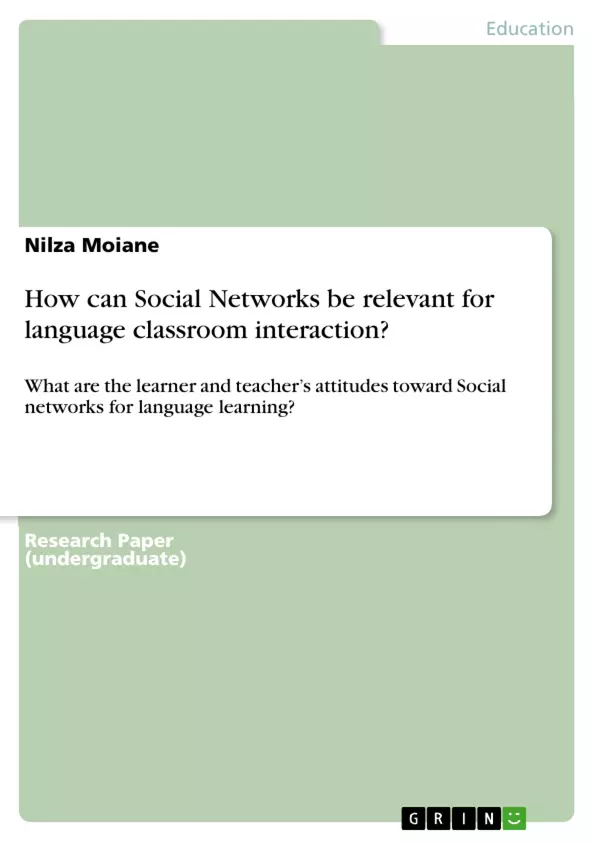One of the longstanding problems in language acquisition is to have excellent level of language
classroom interaction. Recent developments in this issue suggest that interaction must not exist
only in the classroom and the learners must be given the opportunity to use the target language in
different situations. Therefore, the present study aims at suggesting, identifying and describing
tools in Social Network Sites that can foster Language Classroom Interaction.
Given the sense of freedom and autonomy in building network of interaction embedded in social
media, actually, Social Network Sites such as Facebook, Gmail, YouTube, Twitter and
Instagram are authentic resources and platforms to empower language classroom interaction if
the sharing tools within are properly incorporated in a language class. In addition, Social
Network Sites shape tools for life when comes to learn in the classroom and outside the
classroom, because it presents tools that capacity learner in all aspects: cognitive, interactive and
cooperative, and not forgetting learning skills. Furthermore, both learners and teachers, in
Mozambican secondary schools have profiles in, at least, one of these Social Network Sites. The
study shows that they generally access such sites for entertainment and sharing and never for
learning. Among different reasons, lack of knowledge about the learning tools within social
networks and low creativity and innovation in teaching are decisive to low exploitability of the
tools.
The research consists of both qualitative and quantitative methods and the data result from
observations, questionnaires and interviews techniques set in Social Network Sites, especially
Facebook to bring reliable and verifiable samples of the data analyzed. The research
demonstrates how relevant the Social Network Sites are for Language Classroom Interaction and
language acquisition.
Furthermore, an awareness of these tools can possibly be significant to educational contexts to
encourage language learners to interact and collaborate with each other and with native speakers
of the target language through a number of online communication tools such as chat walls,
videos conference, etc., provided by these platforms.
Inhaltsverzeichnis (Table of Contents)
- Introduction
- CHAPTER I: DESCRIPTION OF THE RESEARCH
- Problem Statement
- Aim
- Objective of study
- Research Questions
- Rationale
- Limitation of the study
- CHAPTER II: LITERATURE REVIEW
- CHAPTER III: FINDINGS
Zielsetzung und Themenschwerpunkte (Objectives and Key Themes)
This paper aims to explore the potential of Social Network Sites (SNS) to enhance Language Classroom Interaction (LCI). The research examines the tools available in SNS that can be leveraged to improve language acquisition, particularly in the context of English language learning. It also aims to shed light on the attitudes of teachers and learners towards using SNS for educational purposes.
- The role of SNS in fostering LCI
- Identifying effective tools in SNS for language acquisition
- Understanding teacher and learner perspectives on SNS for language learning
- The impact of SNS on language skills development
- The potential of SNS to bridge the gap between traditional classroom interaction and real-life language use
Zusammenfassung der Kapitel (Chapter Summaries)
- Introduction: This section provides a general overview of the topic, highlighting the potential of SNS to transform LCI in the digital age. It emphasizes the need for research to understand how SNS can be effectively integrated into language learning environments.
- CHAPTER I: DESCRIPTION OF THE RESEARCH: This chapter delves into the research methodology, outlining the problem statement, research questions, rationale, and limitations of the study. It also presents the objectives and aims of the research, highlighting the study's focus on identifying tools in SNS that can foster LCI.
- CHAPTER II: LITERATURE REVIEW: This chapter examines existing literature related to SNS and LCI. It includes a brief overview of the history and development of SNS, followed by a discussion on the use of SNS in language learning contexts.
- CHAPTER III: FINDINGS: This chapter presents the results of the research, analyzing the data collected through various methods such as interviews, questionnaires, and observations. It sheds light on the effectiveness of SNS tools for language acquisition and explores the attitudes of teachers and learners towards utilizing SNS for educational purposes.
Schlüsselwörter (Keywords)
This research focuses on the intersection of Social Network Sites (SNS), Language Classroom Interaction (LCI), and language acquisition. The study explores the potential of SNS platforms to enhance language learning by identifying and analyzing the tools available for this purpose. The research also investigates the attitudes of teachers and learners towards the integration of SNS into language classrooms.
- Arbeit zitieren
- Nilza Moiane (Autor:in), 2017, How can Social Networks be relevant for language classroom interaction?, München, GRIN Verlag, https://www.grin.com/document/477170



